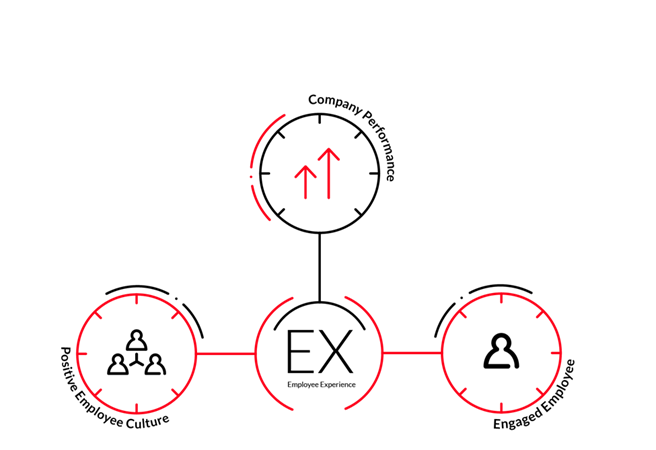Getting real about CX + EX
Are we still trying to make convincing arguments that focusing on the customer experience can improve sales or have a positive impact on a company’s bottom line?
Every major business publication has data that supports and showcases how a positive customer experience impacts sales.
But what about the other side of this equation? What about the employee experience (EX)? The evolution of this strategy includes a holistic corporate experience that also focuses on the employee experience. Human resources and organizational behaviour research have shown that a positive employee culture, with an engaged employee base, can also improve a company’s performance. What follows are direct answers to commonly asked questions about this evolved strategy of EX + CX.

Shouldn’t we put our customers first?
It’s true that organizations need to understand and ensure customer satisfaction, and a positive customer experience, but they ignore the employee experience at their peril. KPMG reports, “there is a growing body of evidence that suggests a clear economic link between employee satisfaction, customer satisfaction and profit. In fact, brands ranked in the top quartile for employee engagement enjoyed (on average) +12% higher customer advocacy and +12% higher profitability than those in the bottom quartile. In addition, Accenture reports that “companies with great EX outperform the Standard & Poor's (S&P) 500 by 122%” and companies with highly engaged workforces are 21% more profitable than those with poor engagement.
What does implementing an EX strategy really mean?
Similar to the maturation of branding, in tandem with what your brand does and says, companies are starting to recognize the need to connect the dots between brand values and the employee experience. For instance, consider what would fall under the wide umbrella of customer experience, then simply replace the concept of the customer with the employee. This includes the Employee Life Cycle (ELC), which is the chronological journey of an employee at your company and includes on-boarding, development, off-boarding, etc. Your customers and your employees should be raving fans of your brand.

This EX model is becoming increasingly more important at the executive level with Accenture reporting that half (51%) of business leaders surveyed are planning to create individualized employee experiences comparable to consumer experiences in the next two years.
Why now?
Thousands of Canadian companies are trying to maintain their businesses, with few focused on employee growth. But mitigating business losses without shifting strategy can be cause in itself for failure.
The global pandemic has been a shock to corporate markets and has significantly altered the business landscape. It’s obvious that the global pandemic has impacted the external environment in which businesses operate. Organizations need to recognize that the internal operations and employee environment have also been significantly impacted by COVID-19.
A recent report by McKinsey highlights that experimentation, adaptability, organizational behaviour, a focus on wellness, and human-centricity are becoming increasingly critical to survival as the COVID-19 pandemic is accelerating the focus on a company’s employee’s needs and requirements. This focus on employees is essentially an Employee Value Proposition (EVP). A company’s EVP is centred on what the organization provides (beyond remuneration) to attract, engage, retain, and delight people. To meet those employee-centric needs, many companies are already strategizing on more holistic, custom-crafted solutions that offer the flexibility to adjust and scale employee programs. EVP-centric organizations are already asking themselves how to prevent burnout, how to support employee mental health, how to provide tools and environments that support collaboration. So in effect, answering how COVID-19 is impacting employees, is the start of determining how the employee experience will change post-pandemic. It is time to start considering a company’s EX and its connection to CX.
Many organizations are seeing the fruition of customer experience strategies centred on their external business environment. The unique business environment created by the pandemic requires maturation of this strategy to a more holistic CX + EX approach, and much deeper consideration for the internal employee experience. Companies need to be resonant and responsive to the demands of the current internal and external business landscape. Strategic misalignment occurs when an organization is unable to initiate change according to the environment.
How do I start strategizing an EX + CX plan?
The fundamental strategic approach to CX and EX are very similar. When we look at the diagram below, organizations typically adopt a cycle of discovery, planning, action and optimization to deliver exceptional customer experiences. The same methodology can be applied to the employee experience.

Discover
Discovery is the most important element to getting EX right. Defining barriers and challenges that hinder an optimized employee experience relies on research and experimentation. The process will not only help identify problem areas but it’s a problem-solving path that will lead you to enhance the overall EX.
Plan
Journeys require a roadmap – navigating without a plan is futile. Employee journeys, like customer journeys, can have different entry points based on needs and where they are in the cycle. Charting the various employee journeys – onboarding, daily tasks, milestones and change management – and co-journeys, will support the main employee blueprint.
Act
Creating a set of leadership principles, driven by the mission and vision of an organization is important to establish a foundation to build on. Every company’s culture is unique, and its leadership framework should be as well. Answer the following questions to guide you:
- Why is this important?
- What impact will this have on the organization and the EX?
- What are the benefits?
Optimize
We often hear of the importance of data-informed decision-making to make better business decisions. What we don’t often discuss is how organizations can create value through implementing best practices and programs derived from workforce data. Data mining within your organization is critical for long-term improvement when it comes to EX. Investing time and resources into developing EX programs takes time but the value-add has a high impact.
EVP-centric organizations that adopt incremental progress will generate small yet consistent wins with their employees. This organizational mindset fosters a nurturing environment where employees feel supported. By nurturing your employees, you’ll ultimately better serve your customers. This measured approach to EX will give you the best chance of influencing other stakeholders and securing lasting momentum.
Authors:
Meghan Sherwin
Anton Morrison
Lori Franze



































